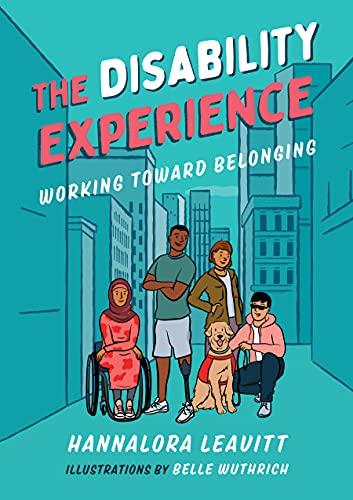
Reviewed by Claire, a Teen Advisory Board Member
“The Disability Experience: Working Toward Belonging” by Hannalora Leavitt is a book intended to encapsulate the variety of ways that having a disability can affect aspects of one’s life through engaging, colorful pages (illustrated by Belle Wuthrich). Leavitt is a blind woman who was raised by a grandmother and mother who both walk with a limp due to the polio virus. Disabilities have always been a very normalized part of her life. However, she continually addresses how our society that is built for able-bodied people views her and other PWDs (how she refers to People With Disabilities in the book) as “others” who do not belong. The purpose of the book is to teach an able-bodied audience to become more familiar with the “other” by learning about what other members of their society face. This is done through an informative tone and textbook-styled features such as bolded definitions, paragraph headings, and image blurbs that make the book very easy to read.
Leavitt succeeds in including a variety of models for approaching disabilities. The book begins by setting a definition for what a disability is, and contrasting how scales of perspectives can differ in how they see disabilities. A key distinction made is between the medical model (which seeks to restore PWDs to “normal” and “fix” them) and the social model (which rather views the organization of our society as the problem that requires mending). Her book follows the social model and focuses on how successful accommodations can help to “reorder” how our society treats disabilities. For example, Leavitt discusses the ways hospitals have made themselves more accessible, and different housing solutions that work for different people and situations. By bringing these solutions into her book, Leavitt provides a clear picture for solutions that are feasible and have already been done in some places. She encourages readers to engage in politics and vote for policymakers that will enact legislation that concretely establishes accessible solutions that will create real impact in PWD’s lives.
Another primary focus of Leavitt’s is improving the knowledge surrounding PWDs. This goes beyond informing the reader, although she does also accomplish this through infographics such as diagrams explaining braille lettering or sections about the continual oppression of PWDs throughout history. At the end, Leavitt emphasized a list of key steps that readers can take to create change, besides voting (this still being very important, of course). Included in this list was encouragement to generate new knowledge by pursuing academic research regarding disabilities and creating technology that can radically improve the lives of PWDs. In these ways, Leavitt seeks to improve both the education of the reader and the content that others can learn in the future.
However, it is important to note that this book has its drawbacks. The synopsis implies that this is a collection of many voices and stories- rather, the content is only from the perspective of Leavitt, with short biographies or inspirational stories in the margins, as one might see in a textbook. Although this is an interesting style that I myself enjoyed, these stories are perhaps not given as much focus as some readers may expect. Another potential criticism is how broadly each topic was discussed. On account of the wide variety of subjects, each one wasn’t given as much detail and depth as some readers may prefer. However, I still highly recommend this book for readers that are interested in learning a lot about PWDs at once and understanding many sectors of their experiences.